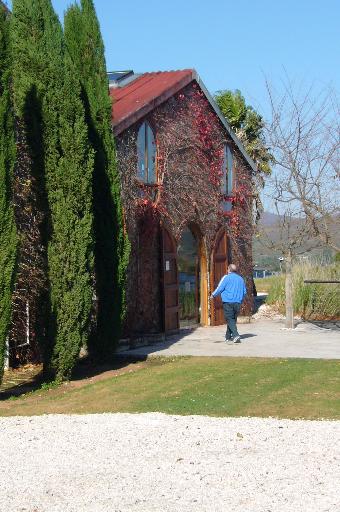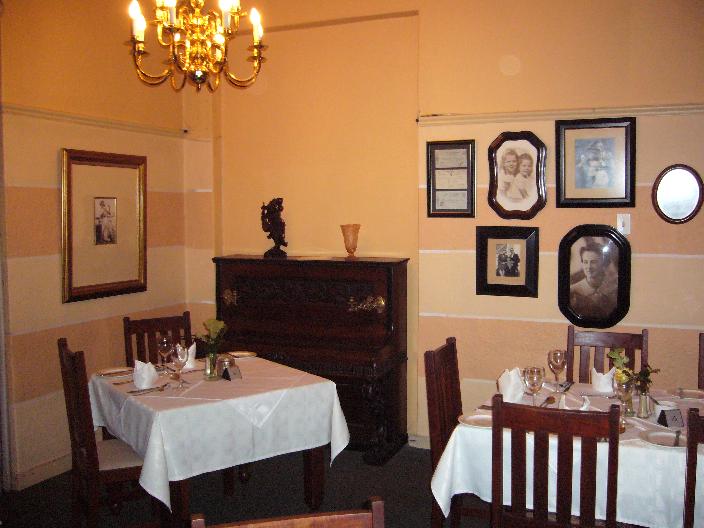Last Sunday’s first installment from the Sunday Times Travel & Food:

As you drive through the Huisrivier Pass from Ladismith to Calitzdrop, cliffs of sheer slate bulge menacingly over your head like naughty children bursting to stick out their tongues for a fat, phlegmy raspberry. The rocks bide their time, for the moment, behind giant metal nets.
This must be the kind of terroir the Prince of Port from the Douro, Dirk van der Niepoort, had in mind when he said he’d driven through fantastic potential vineyard sites for Port on the way to the SA capital of the sweet and spirity stuff that dare not speak its name in a camper van last year. Contorted into fantastic shapes, the slate imparts a fierce minerality to wine made from scarce fruit from hardy vines that can find purchase on their flanks.
One of the twenty two bridges on the pass is sign-posted “Huis 2” which if you annunciate bilingually, sounds like “huistoe” – go home – which is what the Good Value Guru and I were doing after a week spent driving around the Cape Winelands: over 4000 Km traveled, 75 wineries visited, well over 500 wines tasted. The GVG is an old pro when it comes to navigating passes that are more pot-hole that pavement. At least we didn’t have a cow in the back like Stoffel Bek’s cousin Stanley in the David Kramer classic Stanley en die Koei (Stanley and the cow).
This was the GVG’s thirty-fifth trip down south to buy value wine for his informal syndicate. Volumes have grown exponentially to four palettes (each of sixty dozen bottles) thanks to ego pricing at the top end coupled with dodgy upcountry distribution that renders bottles from unfashionable, unconnected or simply small producers scarcer than rocking horse droppings. It’s as if there’s been a coup d’état and Mammon has seized the throne from Bacchus in the Kingdom of SA wine.
Insiders date the coup to around the time Vergelegen released their super-premium red blend called V back in 2001. Vergelegen has long been in the vanguard of SA wine and when they released a red priced at R600 a bottle, the rest of the industry dropped their surfboards and reached for their calculators.
Forget about taste and tradition, money is the metric used to rate SA wine. To while away twenty minute waits at “stop and go’s” on the N12 national road, the GVG and I would count producers offering wine in excess of R200 a bottle. We chose R200 as a threshold for Mammon membership as it is precisely one hundred times more than farmers on the Paardeberg are paid for the grape equivalent of a litre of wine, grapes harvested from their fifty-year old Chenin Blanc bushvines and sold to Co-ops like Swartland and Perdeberg. One ton of these vinous crown jewels nets you R1400 from which around 700 litres of wine is made.
From Beyerskloof to Zandvliet, from Constantia (Uitsig and Klein) to Waterford, from Gary Player to Ernie Els, we counted well over two dozen offerings priced two orders of magnitude higher than our Paardeberg threshold. Of course R200 is small potatoes when it comes to price, as one Constantia winemaker told us Manuka in Tokai had sold eight bottles of venerable Rawsonville Muscat for R30 000 a pop.
Price and its relationship to pleasure was the main theme on a road trip that was at times grueling, at others, gastronomic. But it had to be done as SA wine reportage is driven by producer freebies and travel largesse, with several commentators on winery payrolls as highly paid consultants. Magazines survive on advertizing and brands with biggest spend get most coverage. When we arrived unannounced at remote wineries, we were met with more awe than a Martian touching down in Bonnievale as a traveling pundit is a rara avis indeed.
Powered by BP petrol and fatty Springbok droë wors from Kambro Farm Stall outside Britstown, we were following a hunch that that in some dark cobwebby corner of some remote cellar, palettes of good value wine would be lurking, biding their time. And we found plenty: a whole pocket full of anonymous frogs that after mouth-to-mouth resuscitation, turned out to be white and red-blooded royalty.
The first joined us for dinner on Sunday night at that art deco palace called the Montagu Country Hotel. Tamara de Lempika prints on the walls, Bakelite handles on the sideboard, a silent baby grand in the corner beneath sepia photos of buttoned-up beauties, Leslie Hutchinson on the wireless, the dining room was waiting for Hercule Poirot to come down for dinner.

What to drink with a pair of fatty Karoo lamb chops grilled with a honey glaze? We’d enjoyed a Joubert-Tradauw barrel fermented Chardonnay 2006 (R135) with the potato and leek soup starter – the fresh lime and citrus flavours counterpointing the earthy Irish fare nicely. A Kranskop Merlot 2006 (R95, which they forgot to charge for) was the choice and we were blown away by the fresh acidity and austere yet intense red berry flavours. An auspicious start indeed.
Next week: we drive out to Kranskop and find a rocky terroir where retired Nederburg cellar master Newald Marais now makes some of the best Merlot in SA for all of R45 a bottle. We discover a stunning 2008 vintage Colombard at Goedverwacht that tastes of ruby grapefruit for R20 and at 12% alcohol, makes a super business lunch companion. At the Slanghoek Co-op we are blown away by a 2007 vintage Bordeaux blend for R21 and end up toasting the ghost of Anna Letegan on Nabygelen farm in the Bovlei valley above Wellington.
Contact details
Montagu Country Hotel:
Website: www.montagucountryhotel.co.za;
Tel. 023 614 3125;
Accommodation: Out of season bed and breakfast R295.
Kranskop Estate:
Website: www.kranskopwines.co.za;
Tel. 023 626 3200;
Wine: Kranskop Merlot 2006 – R45 bottle.
Joubert-Tradauw Private Cellar:
Website: www.joubert-tradauw.co.za;
Tel. 028 572 1619;
Wine: Joubert-Tradauw barrel fermented Chardonnay 2006 – R89 bottle.



